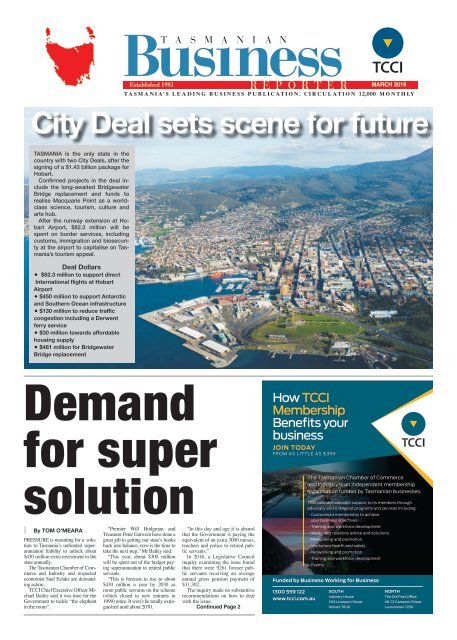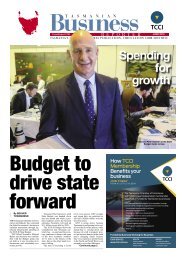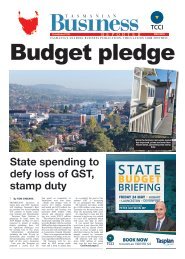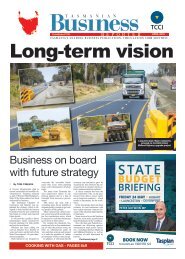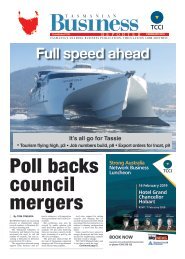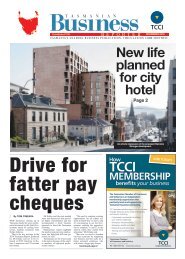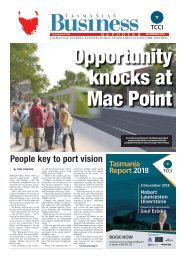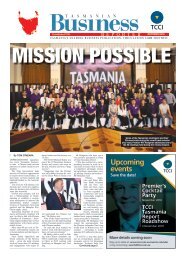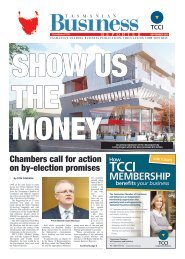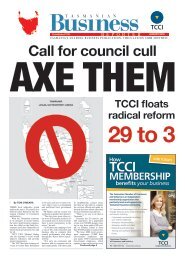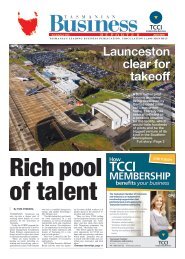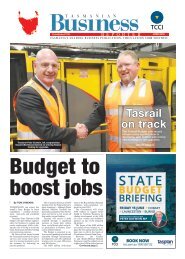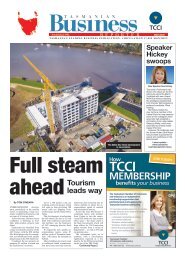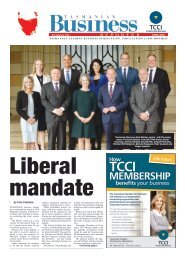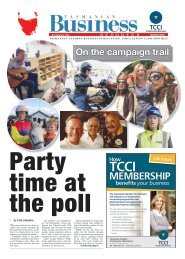Tasmanian Business Reporter March 2019
Welcome to the March edition of the Tasmanian Business Reporter. This month you will read about fresh demands from the TCCI for Government action to find a solution to Tasmania's unfunded superannuation liability, which is forecast to cost the state about $430 million a year by 2030. You will also find details about the $1.43 billion City Deal for Hobart, St.LukesHealth receiving national recognition for a third year running and a recent study finding attracting and retaining skilled staff remains the greatest challenge for Tasmanian small business owners.
Welcome to the March edition of the Tasmanian Business Reporter.
This month you will read about fresh demands from the TCCI for Government action to find a solution to Tasmania's unfunded superannuation liability, which is forecast to cost the state about $430 million a year by 2030.
You will also find details about the $1.43 billion City Deal for Hobart, St.LukesHealth receiving national recognition for a third year running and a recent study finding attracting and retaining skilled staff remains the greatest challenge for Tasmanian small business owners.
Create successful ePaper yourself
Turn your PDF publications into a flip-book with our unique Google optimized e-Paper software.
MARCH <strong>2019</strong><br />
T A S M A N I A’ S L E A D I N G B U S I N E S S P U B L I C A T I O N . C I R C U L A T I O N 12,000 M O N T H LY<br />
City Deal sets scene for future<br />
TASMANIA is the only state in the<br />
country with two City Deals, after the<br />
signing of a $1.43 billion package for<br />
Hobart.<br />
Confirmed projects in the deal include<br />
the long-awaited Bridgewater<br />
Bridge replacement and funds to<br />
realise Macquarie Point as a worldclass<br />
science, tourism, culture and<br />
arts hub.<br />
After the runway extension at Hobart<br />
Airport, $82.3 million will be<br />
spent on border services, including<br />
customs, immigration and biosecurity<br />
at the airport to capitalise on Tasmania’s<br />
tourism appeal.<br />
Deal Dollars<br />
• $82.3 million to support direct<br />
International flights at Hobart<br />
Airport<br />
• $450 million to support Antarctic<br />
and Southern Ocean infrastructure<br />
• $130 million to reduce traffic<br />
congestion including a Derwent<br />
ferry service<br />
• $30 million towards affordable<br />
housing supply<br />
• $461 million for Bridgewater<br />
Bridge replacement<br />
Demand<br />
for super<br />
solution<br />
By TOM O’MEARA<br />
PRESSURE is mounting for a solution<br />
to Tasmania’s unfunded superannuation<br />
liability to unlock about<br />
$430 million extra investment in the<br />
state annually.<br />
The <strong>Tasmanian</strong> Chamber of Commerce<br />
and Industry and respected<br />
economist Saul Eslake are demanding<br />
action.<br />
TCCI Chief Executive Officer Michael<br />
Bailey said it was time for the<br />
Government to tackle “the elephant<br />
in the room”.<br />
“Premier Will Hodgman and<br />
Treasurer Peter Gutwein have done a<br />
great job in getting our state’s books<br />
back into balance, now is the time to<br />
take the next step,” Mr Bailey said.<br />
“This year, about $300 million<br />
will be spent out of the budget paying<br />
superannuation to retired public<br />
servants.<br />
“This is forecast to rise to about<br />
$430 million a year by 2030 as<br />
more public servants on the scheme<br />
(which closed to new entrants in<br />
1999) retire. It won’t be totally extinguished<br />
until about 2070.<br />
“In this day and age it is absurd<br />
that the Government is paying the<br />
equivalent of an extra 3000 nurses,<br />
teachers and police to retired public<br />
servants.”<br />
In 2016, a Legislative Council<br />
inquiry examining the issue found<br />
that there were 9261 former public<br />
servants receiving an average<br />
annual gross pension payment of<br />
$31,302.<br />
The inquiry made no substantive<br />
recommendations on how to deal<br />
with the issue.<br />
Continued Page 2<br />
How TCCI<br />
Membership<br />
Benefits your<br />
business<br />
JOIN TODAY<br />
FROM AS LITTLE AS $399<br />
Funded by <strong>Business</strong> Working for <strong>Business</strong><br />
1300 559 122<br />
www.tcci.com.au<br />
The <strong>Tasmanian</strong> Chamber of Commerce<br />
and Industry is an independent membership<br />
organisation funded by <strong>Tasmanian</strong> businesses.<br />
TCCI provides valuable support to its members through<br />
advocacy and a range of programs and services including:<br />
• Customised membership to achieve<br />
your business objectives<br />
• Training and workforce development<br />
• Workplace relations advice and solutions<br />
• Networking and promotion<br />
• Workplace health and safety<br />
• Networking and promotion<br />
• Training and workforce development<br />
• Events<br />
SOUTH<br />
Industry House<br />
309 Liverpool Street<br />
Hobart 7000<br />
NORTH<br />
The Old Post Office<br />
68-72 Cameron Street<br />
Launceston 7250
T A S M A N I A’ S L E A D I N G B U S I N E S S P U B L I C A T I O N . C I R C U L A T I O N 12,000 M O N T H LY<br />
2 <strong>Tasmanian</strong> <strong>Business</strong> <strong>Reporter</strong> - MARCH <strong>2019</strong><br />
NEWS<br />
Tassie contracts let StLukes wins awards trifecta<br />
Local jobs<br />
in the wind<br />
GOLDWIND has appointed<br />
Crisp Bros &<br />
Haywards for a major<br />
tower supply contract for<br />
its $300 million Cattle<br />
Hill Wind Farm.<br />
Twenty per cent of<br />
the tower components<br />
required for the 48 turbines<br />
at the Central Highlands<br />
development will<br />
be manufactured by the<br />
Haywards team in an $8<br />
million deal.<br />
Goldwind Managing<br />
Director John Titchen<br />
said a number of <strong>Tasmanian</strong><br />
project partners<br />
were working to make<br />
the construction of the<br />
wind farm possible.<br />
Hazell Bros is undertaking<br />
the full civil and<br />
electrical works for the<br />
project while Gradco is<br />
completing over $10 million<br />
of road upgrades in<br />
T A S M A N I A’ S L E A D I N G B U S I N E S S P U B L I C A T I O N . C I R C U L A T I O N 12,000 M O N T H LY<br />
e dition<br />
<strong>Tasmanian</strong> <strong>Business</strong> <strong>Reporter</strong> can now be delivered directly to your inbox. With our 30,000-strong monthly print<br />
readership, our new up-to-date digital distribution will keep <strong>Tasmanian</strong>s abreast of the all latest in local business<br />
news. From this month we will distribute electronic editions of the <strong>Tasmanian</strong> <strong>Business</strong> <strong>Reporter</strong> as we go to print.<br />
To confirm your copy sign up to our mailing list via<br />
tbreditorial@fontpr.com.au<br />
T A S M A N I A’ S L E A D I N G B U S I N E S S P U B L I C A T I O N . C I R C U L A T I O N 12,000 M O N T H LY<br />
Tasmania’s business newspaper is published monthly by the<br />
<strong>Tasmanian</strong> Chamber of Commerce and Industry. It is distributed<br />
to businesses in Tasmania as well as key decision-makers.<br />
Circulation: 12,000<br />
BUSINESS<br />
Haywards has won an $8m contract to build<br />
towers for Goldwind.<br />
the region to facilitate the<br />
development.<br />
“Alongside our major<br />
project partners are many<br />
local subcontractors and<br />
suppliers that are critical<br />
to the construction of<br />
the project,” Mr Titchen<br />
said.<br />
Haywards has also<br />
been engaged by Hazell<br />
Bros for a $4 million<br />
contract to assist with<br />
the production of tower<br />
foundations for the turbines.<br />
Construction of<br />
Cattle Hill Wind Farm<br />
started in mid-2018 and<br />
is expected to be fully<br />
operational in late <strong>2019</strong>.<br />
Progress was temporarily<br />
halted by the Central<br />
Highlands bushfires<br />
in January.<br />
About 120 staff are<br />
back working on site,<br />
with up to 150 expected<br />
during peak construction.<br />
Managing Editor: Tom 2O’Meara<br />
0418 135 822<br />
Editor: Becher Townshend<br />
0418 370 661<br />
Advertising and Special Projects<br />
Gil Sellars 0448 901 371<br />
gil@thetrustedmediaco.com<br />
HOBART’S Editorial BEST & Advertising RANGE OF<br />
TBReditorial@fontpr.com.au<br />
FOR THE www.tasmanianbusinessreporter.com.au<br />
HOME AND OFFICE<br />
Publisher:<br />
We specialise <strong>Tasmanian</strong> in high Chamber quality ergonomic of Commerce chairs, and Industry<br />
alternative seating<br />
309 Liverpool<br />
and electronic<br />
St, Hobart,<br />
sit/stand<br />
TAS<br />
desks.<br />
7000<br />
Flair Ph: Office 6236 Furniture 3600 has Fax: been 6231 providing 1278 quality, admin@tcci.com.au<br />
affordable office<br />
furniture to homes and offices throughout the Hobart region<br />
for nearly 15 The years. Old We’re Post a locally-based, Office, 68-72 family-run Cameron business St,<br />
specialising in all types of Launceston products, so why TAS not 7250 visit us today to<br />
see our fantastic Ph: range? 6331 1144 laun@tcci.com.au<br />
Production:<br />
Phone 6234 1127<br />
aldridge.media<br />
260 Argyle Street,<br />
Ph: 0431 241 775<br />
North Hobart<br />
aldridge.media@iinet.net.au<br />
Printer: Mercury<br />
www.flairofficefurniture.com.au<br />
Level 1, 2 Salamanca Square, Hobart, 7000<br />
BUSINESS<br />
YOUR QUICK GUIDE TO SERVICES AND PRODUCTS FOR YOUR BUSINESS<br />
QUALITY ERGONOMIC FURNITURE<br />
TASMANIA’S<br />
St.LukesHealth has<br />
been named Australia’s<br />
number one private<br />
health insurer for<br />
customer satisfaction<br />
at the Roy Morgan<br />
Awards.<br />
It’s the third<br />
consecutive year the<br />
not-for-profit health<br />
fund has claimed the<br />
title.<br />
CEO Paul Lupo<br />
said the fund was<br />
committed to its<br />
promise to help<br />
members stay healthy,<br />
get well, live better and<br />
deliver peace of mind.<br />
“We are extremely<br />
humbled that our<br />
members have<br />
acknowledged the<br />
service and products<br />
we deliver as the best<br />
in Australia,” Mr Lupo<br />
said.<br />
“Members continue<br />
to invite us to partner<br />
with them in their<br />
health journey, with<br />
membership of the<br />
fund continuing to<br />
To see your business here, call Kerri on 0419 750 267 or email kerri@thetrustedmediaco.com<br />
Demand for super solution<br />
From Page 1<br />
Mr Bailey said that if<br />
a solution was agreed on,<br />
the forecast recurrent expenditure<br />
could be better<br />
invested in infrastructure<br />
and essential services<br />
like health.<br />
As Treasurer in the<br />
Groom Government, former<br />
Premier Tony Rundle<br />
had the foresight to<br />
set up a fund in the 1990s<br />
to cover this cost.<br />
“On Mr Rundle’s original<br />
plan, by 2017 this<br />
fund would have funded<br />
the superannuation costs<br />
from outside the budget,”<br />
Mr Bailey said.<br />
“Unfortunately, those<br />
funds were spent by Premiers<br />
David Bartlett and<br />
Lara Giddings during the<br />
Global Financial Crisis,<br />
leaving us in the situation<br />
we are today.”<br />
The cost could be par-<br />
WANTED<br />
<strong>Business</strong><br />
movers and<br />
shakers<br />
• Promotions<br />
• Appointments<br />
• Awards<br />
• Celebrating<br />
success<br />
Share the news<br />
with the<br />
<strong>Tasmanian</strong><br />
business<br />
community<br />
Send your news<br />
snippets, with a<br />
high quality photo,<br />
to TBReditorial@<br />
fontpr.com.au<br />
Head of customer care and delivery Helen Cowley, left, head of brand<br />
and communications Grayson Genders, vice-chair Mel Lukianenko<br />
and communications and member engagement coordinator Rochelle<br />
Galloway.<br />
grow steadily.<br />
“As private health<br />
insurance customers<br />
are increasingly look<br />
tially offset by the sale of<br />
non-key assets, he said.<br />
“In the past, it has been<br />
accepted wisdom that assets<br />
should only be sold<br />
if the money is going to<br />
be reinvested into new,<br />
productive infrastructure,”<br />
Mr Bailey said.<br />
“However, given the<br />
recurrent cost to the budget,<br />
and the 50 year tail,<br />
there is a very good argument<br />
to be made that sale<br />
funds should be set aside<br />
to help offset the cost to<br />
the budget of the superannuation<br />
liability.<br />
“For example, the sale<br />
of non-core assets like<br />
the Motor Accident Insurance<br />
Board wouldn’t<br />
cover all of the cost, but<br />
if the proceeds were invested<br />
in a similar way to<br />
the one-off Mersey Hospital<br />
sale funds, the funds<br />
could be drawn down<br />
Your Partner<br />
in Print.<br />
www.footandplaysted.com.au<br />
Now incorporating<br />
THE CRAFT LIVES ON.<br />
around for a better<br />
deal, they are finding<br />
that St.LukesHealth,<br />
as a member-centric,<br />
over a period of, say, 10<br />
years and offset against<br />
the annual super bill.<br />
“This would reduce the<br />
annual drain on the budget<br />
for the next decade.”<br />
Mr Bailey said all options<br />
needed researching,<br />
with one more radical<br />
option being legislation<br />
to retrospectively cap entitlements<br />
under the defined<br />
benefit scheme.<br />
“The Government’s superannuation<br />
liability is<br />
the biggest threat to the<br />
future prosperity of the<br />
state, it’s time a solution<br />
was found and finally acted<br />
upon,” Mr Bailey said.<br />
Mr Eslake raised similar<br />
concerns in his 2018<br />
Tasmania Report in December,<br />
saying the issue<br />
was a significant blemish<br />
on Tasmania’s strong financial<br />
scorecard.<br />
“For several decades<br />
not-for-profit fund is<br />
proving to be the right<br />
fit for their health care<br />
needs.”<br />
the unfunded super liability<br />
will continue to<br />
represent a constraint<br />
on <strong>Tasmanian</strong> Governments<br />
flexibility and a<br />
source of risk to future<br />
budgets,” Mr Eslake<br />
said.<br />
“In particular it means<br />
that present and future<br />
<strong>Tasmanian</strong> Governments<br />
have less scope<br />
than the governments of<br />
other states and territories<br />
for borrowing even<br />
at the present relatively<br />
low interest rates in order<br />
to fund worthwhile<br />
infrastructure investments.”<br />
Tasmania’s liability is<br />
the biggest in Australia<br />
and is the reason why<br />
Tasmania doesn’t have a<br />
AAA rating, which forces<br />
the state to pay higher<br />
interest rates on borrowings.
T A S M A N I A’ S L E A D I N G B U S I N E S S P U B L I C A T I O N . C I R C U L A T I O N 12,000 M O N T H LY<br />
<strong>Tasmanian</strong> <strong>Business</strong> <strong>Reporter</strong> - MARCH <strong>2019</strong> 3<br />
NEWS<br />
Small businesses face staff challenge<br />
Skilled workers wanted<br />
ATTRACTING and retaining<br />
skilled staff and filling apprentice<br />
and qualified tradespeople<br />
positions remains the greatest<br />
challenge for the state’s small<br />
business owners.<br />
That’s the key finding of<br />
a new study by <strong>Tasmanian</strong><br />
Leaders’ Alumni.<br />
Graduates of the leadership<br />
program recently surveyed<br />
more than 130 businesses representing<br />
a variety of sectors<br />
including agriculture, hospitality,<br />
tourism and retail.<br />
A summary of conversations<br />
have been released in a<br />
document titled: What stops<br />
us? Small business: overcoming<br />
obstacles and seizing opportunities.<br />
<strong>Business</strong>es reported exciting<br />
opportunities existed in the<br />
growth in tourism numbers to<br />
the state, online sales growth<br />
and leveraging the development<br />
of trusted brands and opportunities<br />
internationally.<br />
The highlight for small<br />
business owners and operators<br />
included forming bonds and<br />
being part of a local community,<br />
flexibility of lifestyle and<br />
family life and creating strong<br />
and real relationships through<br />
the business.<br />
One of the most significant<br />
challenges identified by small<br />
businesses surveyed was<br />
skilled staff and apprentice attraction<br />
and retention.<br />
Building resilience and<br />
wellbeing was deemed important<br />
to guard against the<br />
ups and downs of operating a<br />
small business.<br />
The significance of research<br />
and planning as well<br />
as accessing support outside<br />
the business sector were also<br />
highlighted.<br />
Government assistance for<br />
small business should include<br />
support through finance and<br />
education and incentives to<br />
employ people, respondents<br />
said.<br />
“The aim of this document<br />
is to inform future work supporting<br />
small business in Tasmania<br />
as well as feedback to<br />
the small businesses surveyed<br />
as part of the Thinkbank process,”<br />
general manager Angela<br />
Driver said.<br />
“Thinkbanks are held annually<br />
with a select number<br />
of <strong>Tasmanian</strong> Leaders alumni<br />
to address a topical issue for<br />
Tasmania and are designed<br />
and conducted to give those<br />
involved practical ideas and<br />
tools to develop their organisations<br />
and more widely the<br />
state.”<br />
The report is available on<br />
the <strong>Tasmanian</strong> Leaders’ website.<br />
Silos eatery<br />
judged top<br />
newcomer<br />
Grain of the Silos food director, chef and TV personality<br />
Massimo Mele.<br />
LAUNCESTON’S Grain<br />
of the Silos restaurant<br />
at Peppers Silo Hotel<br />
has won Gault&Millau<br />
Australia’s New Restaurant<br />
of the Year award.<br />
Peppers Silo Hotel<br />
General Manager,<br />
Paul Seaman said the<br />
independent award,<br />
presented in Sydney in<br />
early February, recognised<br />
the restaurant team’s<br />
ability to create a dining<br />
space and menu unlike<br />
any other.<br />
Grain of the Silos<br />
opened in June 2018 as<br />
part of the $25 million<br />
redevelopment of the old<br />
Kings Wharf silos into a<br />
boutique hotel.<br />
The kitchen is led by<br />
head chef Peter Twitchett<br />
and food director and TV<br />
personality Massimo Mele.<br />
“This award win is<br />
testament to the hard work<br />
and passion that has gone<br />
into creating, sustaining<br />
and growing Grain of the<br />
Silos,” Mr Seaman said.<br />
“Our chefs have<br />
met each farmer, each<br />
maker, and each talented<br />
<strong>Tasmanian</strong> who brings<br />
something extraordinary<br />
to the restaurant’s ever<br />
changing list of dishes.”<br />
Gault&Millau Australia’s<br />
team of qualified<br />
restaurant reviewers<br />
evaluated more than 850<br />
restaurants across all<br />
Australian capital cities<br />
and major regional areas<br />
last year to choose the<br />
best of the best.<br />
WANTED<br />
<strong>Business</strong><br />
movers and<br />
shakers<br />
• Promotions<br />
• Appointments<br />
• Awards<br />
• Celebrating<br />
success<br />
Share the news<br />
with the<br />
<strong>Tasmanian</strong><br />
business<br />
community<br />
Send your news<br />
snippets, with a<br />
high quality photo,<br />
to TBReditorial@<br />
fontpr.com.au
4 <strong>Tasmanian</strong> <strong>Business</strong> <strong>Reporter</strong> - MARCH <strong>2019</strong><br />
THOUGHT LEADERSHIP<br />
www.tcci.com.au<br />
National grid on election agenda<br />
INFRASTRUCTURE<br />
Australia’s inclusion of<br />
Tasmania’s Marinus interconnector<br />
project on<br />
its list is vital for the<br />
state.<br />
Tasmania is poised –<br />
with proper and immediate<br />
funding from both<br />
the Commonwealth and<br />
State Governments – to<br />
play a significant role in<br />
the national electricity<br />
grid.<br />
The next step is the<br />
feasibility study for<br />
Marinus, through the<br />
Australian Renewable<br />
Energy Agency.<br />
The TCCI will be<br />
chasing this, placing this<br />
project and the issue of<br />
Tasmania’s place in the<br />
national grid as a Federal<br />
election issue.<br />
Energy security is becoming<br />
one of the most<br />
important issues for the<br />
whole of Australia.<br />
Last month Adelaide<br />
experienced a record<br />
week of hot weather –<br />
which in turn put enough<br />
pressure on the South<br />
Australian grid to cause<br />
blackouts.<br />
Days later, Victoria experienced<br />
a similar situation<br />
with the heatwave<br />
impacting the grid to the<br />
extent that traffic lights<br />
Michael<br />
Bailey<br />
TCCI Chief Executive<br />
were out and that state’s<br />
residents were told not<br />
to use dishwashers, dryers<br />
and other high energy<br />
use appliances.<br />
What is interesting<br />
about this is, as well<br />
as frustrating from the<br />
point of view of earning<br />
revenue for the entire<br />
state, Tasmania had<br />
more than 400 megawatts<br />
of latent energy it<br />
could not transport over<br />
ABOVE: Taraleah is just one power station to be upgraded in the<br />
Battery of the Nation project. LEFT: A second interconnector, Marinus,<br />
is vital for Tasmania’s economic future.<br />
Basslink, because the<br />
cable was already at full<br />
capacity.<br />
This is just one example<br />
of why the second<br />
interconnector, Marinus,<br />
is so vital – a second cable<br />
capable of carrying<br />
1200MW.<br />
With Marinus, existing<br />
wind power developments<br />
will double<br />
and even more<br />
crucially, the development<br />
of “pumped<br />
hydro” hinges on the<br />
second interconnector<br />
becoming a reality.<br />
Pumped hydro has the<br />
potential to double the<br />
current <strong>Tasmanian</strong> generation<br />
capacity.<br />
Over the next 10 to<br />
15 years, Hydro Tasmania<br />
has the opportunity<br />
to rollout the pumped<br />
hydro projects which<br />
could add upwards of<br />
2500MW to the grid.<br />
Names like Lake Margaret,<br />
Lake Rosebery,<br />
Lake Murchison, Lake<br />
Cethana, Lake Rowallan,<br />
Great Lake/yingina and<br />
Lake Echo already hold<br />
great history in energy<br />
generation – but there<br />
could be up to 4800MW<br />
of pumped hydro attached<br />
to them.<br />
Factor in that every<br />
600MW will cost $1.5<br />
million to build, there<br />
could be a $900 million<br />
investment on just one of<br />
the sites.<br />
And with that investment<br />
comes jobs – construction<br />
at the sites, improved transport<br />
infrastructure and engineering<br />
of many and varied<br />
disciplines.<br />
With the overall project<br />
time being over a decade<br />
that means future longterm<br />
jobs for <strong>Tasmanian</strong>s<br />
of all ages.<br />
The TCCI is calling on<br />
both sides of politics to<br />
commit to this critical infrastructure<br />
project.<br />
With development lag<br />
times of development –<br />
for example, a full year of<br />
manufacture in a European<br />
factory to make a cable –<br />
we need the commitment<br />
now.<br />
Tasmania can truly become<br />
“The Battery of the<br />
Nation” and the TCCI<br />
will be fighting for that<br />
outcome.<br />
Directors promise to win back trust<br />
THE resignations of<br />
NAB’s chairman and chief<br />
executive in the wake of<br />
the royal commission’s<br />
final report is the first acknowledgment<br />
of the<br />
changes expected in corporate<br />
culture to restore<br />
community faith. As dramatic<br />
as they were, the resignations<br />
were not enough<br />
to make the community<br />
believe this change will<br />
happen.<br />
Poor cultural practices<br />
in institutions have be-<br />
ANGUS ARMOUR, AICD<br />
managing director and<br />
chief executive officer<br />
come entrenched over decades.<br />
Commissioner Kenneth<br />
Hayne’s report is<br />
an important catalyst for<br />
change, and if our institutions<br />
want to regain public<br />
trust, they must respond<br />
positively. As the peak<br />
organisation focused on<br />
building the capability of<br />
Australia’s community of<br />
directors, the people who<br />
must take ultimate responsibility<br />
for corporate<br />
behaviour in this country,<br />
the Australian Institute<br />
of Company Directors<br />
strongly supports positive<br />
change and intends to lead<br />
this process.<br />
While Commissioner<br />
Hayne recognised that<br />
the underlying structure<br />
of our system of boards<br />
and management is sound,<br />
he was critical of the approach<br />
taken in financial<br />
services in three respects:<br />
• a prioritisation of<br />
short-term profit over customer<br />
and stakeholder interests;<br />
• a system of bonuses<br />
and rewards that can<br />
encourage unethical behaviour;<br />
and<br />
• a lack of insight into<br />
corporate culture and<br />
challenge of management.<br />
A recurring theme in<br />
the Hayne report is that<br />
boards and directors need<br />
a significant shift in intensity<br />
in their oversight of<br />
non-financial risk to mitigate<br />
the risk of further<br />
misconduct.<br />
This will require boards<br />
to invest more time and<br />
energy on the key questions<br />
and challenges in<br />
their organisation, without<br />
involving themselves in<br />
the day-to-day management<br />
of the organisation.<br />
While the AICD<br />
strongly endorses Commissioner<br />
Hayne’s view<br />
that directors consider the<br />
interests of all stakeholders<br />
when acting in the<br />
best interests of the company,<br />
evidence before the<br />
Commission rightly has<br />
the community questioning<br />
whether this occurs in<br />
practice.<br />
That requires working<br />
with all stakeholders in<br />
the pursuit of long-term<br />
value creation.<br />
Market participants,<br />
including institutional investors,<br />
need to be prepared<br />
to shift their focus<br />
from purely short-term financial<br />
metrics that have,<br />
on occasion, resulted in<br />
perverse outcomes.<br />
• This article first appeared in<br />
The Australian, 18/02/<strong>2019</strong>.<br />
www.tasmanianbusinessreporter.com.au<br />
Talk directly to <strong>Business</strong><br />
Leaders, Managers<br />
and Owners<br />
....the decision makers.<br />
Tell your unique story to<br />
the decision makers.<br />
No other medium can talk directly to business like the BUSINESS <strong>Reporter</strong> can.<br />
30,000 PRINT<br />
READERS<br />
+<br />
5,000 ONLINE<br />
SUBSCRIBERS<br />
Imagine 30,000 business news readers statewide, plus over 5,000 Online subscribers<br />
who get the latest business news that matters to them.<br />
EXPLORE THE POSSIBILITIES.<br />
Ask about the editorial/advertising package that delivers a direct hit to your market.<br />
See how the <strong>Tasmanian</strong> BUSINESS reporter can<br />
build your brand awareness.<br />
• Call Gil Sellars on 0448 901 371<br />
• gil@thetrustedmediaco.com
<strong>Tasmanian</strong> <strong>Business</strong> <strong>Reporter</strong> - MARCH <strong>2019</strong> 5<br />
THOUGHT LEADERSHIP<br />
www.tcci.com.au<br />
Fanfare for future proofing<br />
I FOUND myself standing<br />
an inch taller on<br />
February 17 when the<br />
new Toll vessel – <strong>Tasmanian</strong><br />
Achiever II –<br />
was officially named in<br />
Burnie.<br />
A sausage sizzle and<br />
face painting marquee<br />
on the wet deck mixed<br />
with the sounds of a<br />
brass band set the scene<br />
for familiar faces (and<br />
their families) of the <strong>Tasmanian</strong><br />
logistics scene<br />
to witness the successful<br />
launch of a bottle of<br />
Tassie bubbles and shatter<br />
into a million pieces<br />
– successfully ticking off<br />
the “good luck” superstition.<br />
Prime Minister Scott<br />
Morrison and Premier<br />
Will Hodgman, along<br />
with mayors, chairmen,<br />
captains and other titles<br />
mixed with all on board<br />
and sang the national anthem<br />
with pride.<br />
It was one of those moments<br />
when the industry<br />
comes together to pay<br />
homage to a moment in<br />
time that showcases just<br />
how important the ship-<br />
Brett<br />
Charlton<br />
Agility Logistics<br />
ping and logistics world<br />
is and how the commitment<br />
to prepare for the<br />
future is being invested<br />
in heavily by those that<br />
cater for the growth in<br />
trade.<br />
Adding about 46 per<br />
cent additional capacity<br />
to the Toll service, there<br />
is no question that these<br />
new vessels (the <strong>Tasmanian</strong><br />
Achiever II and the<br />
Victorian Reliance II)<br />
will go a long way to “future<br />
proof” Tasmania.<br />
Coupled with the<br />
Searoad’s investment<br />
of last year and another<br />
new vessel to come as<br />
well as the new TT Line<br />
vessels in coming years<br />
the question of capacity<br />
should be a moot issue<br />
for a few years at least<br />
– in fact, if we are complaining<br />
about capacity<br />
in 10 years’ time then we<br />
are having a great growth<br />
problem to consider.<br />
Again acknowledging<br />
the great work going into<br />
the securing of the freight<br />
task for Tasmania – over<br />
coffees and whiskies<br />
around the state, the conversation<br />
invariably turns<br />
to pricing.<br />
The costs of Australian<br />
wages (crew and terminal)<br />
along with investment<br />
returns ($172m of<br />
new vessel) will need to<br />
be recovered and constant<br />
increases in costs in fuel<br />
mixed with infrastructure<br />
surcharges etcetera,<br />
will be the narrative by<br />
the commercial arm of<br />
the carriers across Bass<br />
Strait.<br />
However, prices for<br />
airfares drops when there<br />
are spare seats. It will be<br />
an interesting year for Tasmania<br />
and I am confident<br />
whatever the questionable<br />
outstandings are, the bottom<br />
line is that Tasmania<br />
is in a better place with<br />
two shiny new green ships<br />
going across the 369kms<br />
of H2O and salt that is our<br />
natural moat protecting us<br />
from the congested highways<br />
of the big island.<br />
TOP: The new Toll vessel <strong>Tasmanian</strong><br />
Achiever II.<br />
ABOVE: PM Scott Morrison visits the<br />
bridge of the vessel during it’s naming<br />
function in Buirnie .<br />
Action plan for market access help<br />
THE Australian Government<br />
has launched an<br />
action plan to help primary<br />
producers and other<br />
businesses tackle trade<br />
barriers around market<br />
access, to help them get<br />
their goods into international<br />
markets faster.<br />
Just like we do in Australia,<br />
international governments<br />
have the right<br />
to protect their country’s<br />
biosecurity and environment<br />
but excessive protection<br />
and delays without<br />
reason are extremely<br />
frustrating to our exporters.<br />
Non-tariff barriers are<br />
being addressed under<br />
the action plan with the<br />
establishment of a ded-<br />
Sally<br />
Chandler<br />
Tradestart Adviser<br />
icated website - www.<br />
tradebarriers.dfat.gov.au<br />
– with an in-built function<br />
to report trade barriers.<br />
I am very pleased to<br />
advise I have had my first<br />
success using the website.<br />
A client’s market access<br />
problem with China,<br />
which had been going on<br />
for many months, was<br />
addressed and fixed. The<br />
client now has market<br />
access for that particular<br />
product which will allow<br />
the export of many millions<br />
of dollars’ worth of<br />
the product over the next<br />
few years.<br />
It’s a fantastic outcome<br />
which shows the<br />
new plan and website do<br />
work.<br />
Naturally, some issues<br />
will take longer than others<br />
to fix and some may<br />
be very hard to solve.<br />
Australia has 22 Agricultural<br />
Counsellors<br />
employed in selected<br />
countries who work with<br />
those importing countries<br />
to remove technical<br />
barriers to trade.<br />
Our technical experts<br />
and trade officials in both<br />
Australia and offshore<br />
can only work as fast as<br />
the importing country allows<br />
progress to occur,<br />
but the additional assistance<br />
and focus of the action<br />
plan which supports<br />
closer collaboration between<br />
government and<br />
industry is extremely<br />
welcome.<br />
For international trade and investment assistance contact the<br />
TCCI’s TradeStart Adviser, Sally Chandler, at sally.chandler@<br />
tcci.com.au or phone 1300 559 122.
6 <strong>Tasmanian</strong> <strong>Business</strong> <strong>Reporter</strong> - MARCH <strong>2019</strong><br />
THOUGHT LEADERSHIP<br />
www.tcci.com.au<br />
Our health is worth insuring<br />
Paul<br />
Lupo<br />
CEO, StLukesHealth<br />
IN Australia, we have<br />
come to expect that we<br />
can access health treatment<br />
straight away.<br />
However, sometimes<br />
accessing healthcare<br />
means having to wait for<br />
treatment, especially for<br />
those Australians without<br />
private health insurance.<br />
Each year on April<br />
1, health funds across<br />
Australia release their<br />
new premium rates for<br />
the coming 12 months<br />
and naturally consumers<br />
question whether they<br />
are receiving value for<br />
money through their private<br />
health insurance.<br />
And it is a hard decision<br />
to make. The true<br />
cost of maintaining your<br />
health is not simple to<br />
calculate as you cannot<br />
foresee the need for, and<br />
the potential cost of treatment.<br />
For example, a simple<br />
hip replacement could<br />
cost you $30,000.<br />
In comparison, if you<br />
have comprehensive car<br />
THE end of 2018 and the<br />
start of <strong>2019</strong> saw a number<br />
of legislative changes<br />
in the realm of employment<br />
law, including but<br />
not limited to –<br />
• a further decision<br />
regarding the case of<br />
Workpac Pty Ltd v Skene<br />
[2018] FCAFC 131.<br />
In light of the potential<br />
“double dipping” that<br />
may have resulted from<br />
this case where a casual<br />
employee successfully<br />
argued they were a permanent<br />
employee the<br />
Government has chosen<br />
to step in.<br />
The concern from employers<br />
here was that an<br />
employee could potentially<br />
receive the casual<br />
loading as well as the<br />
benefits of permanent<br />
employment.<br />
The Government says<br />
they will introduce regulations<br />
that make it clear<br />
that this “double dipping”<br />
cannot be claimed.<br />
• From October 1,<br />
2018 all regular casual<br />
employees covered<br />
by Modern Awards will<br />
have the right to request<br />
that their employment<br />
be converted to perma-<br />
insurance and you decide<br />
to change to third-party<br />
insurance you know your<br />
potential loss is limited<br />
to the cost of replacing<br />
your car.<br />
According to Private<br />
Healthcare Australia’s<br />
Annual High Claims<br />
2018 Report, private<br />
health insurers paid<br />
more than 17,000 claims<br />
with benefits exceeding<br />
$10,000 for people aged<br />
under 30.<br />
The highest claim for a<br />
private health insurance<br />
member under 30 was for<br />
a 16-year-old male with<br />
gastrointestinal bleeding<br />
with a cost of $221,195.<br />
Despite the high potential<br />
costs of healthcare,<br />
many young Australians<br />
do not see the value in<br />
private health insurance<br />
and live by the belief that<br />
“it won’t happen to me”.<br />
While wage growth<br />
has stagnated and household<br />
debt is at an all-time<br />
high, the rise of buy-now,<br />
pay-later services is tout-<br />
Be aware of changes<br />
Abbey<br />
George<br />
Workplace Relations<br />
nent employment. This<br />
followed the insertion<br />
of a standard casual conversion<br />
clause into 85<br />
Awards on July 5, 2017.<br />
• On December 12,<br />
2018 the Fair Work<br />
ed as an alternative solution<br />
to those requiring urgent<br />
healthcare.<br />
Buy-now, pay-later<br />
schemes are increasingly<br />
being promoted by some<br />
health providers, particularly<br />
optometrists, dentist<br />
and fertility clinics,<br />
meaning that high-value<br />
purchases – or access to<br />
You can contact TCCI on the Helpline on 1300 765 123 or the TCCI on 1300 59 122 or workplacerelations@tcci.com.au<br />
In 2018, St.LukesHealth paid more than $9 million on preventative dental services.<br />
Amendment (Family<br />
and Domestic Violence<br />
Leave) Act 2018 took effect.<br />
This means that the<br />
Fair Work Act 2009 now<br />
also includes a provision<br />
that employees are entitled<br />
to unpaid family<br />
domestic violence leave<br />
as part of the National<br />
Employment Standards<br />
and applies to all employees<br />
from December<br />
12, 2018.<br />
The amendment follows<br />
on from the introduction<br />
of unpaid domestic<br />
violence leave<br />
into Modern Awards in<br />
August 2018.<br />
As it is now also contained<br />
in the National<br />
Employment Standards<br />
this means that even employees<br />
not covered by<br />
a Modern Award will be<br />
able to access the leave.<br />
• In January <strong>2019</strong> the<br />
Fair Work Amendment<br />
(Repeal of Four Yearly<br />
Reviews and other Measures)<br />
Act 2018 (Amending<br />
Act) revised s 188(2)<br />
of the Fair Work Act<br />
2009 which now allows<br />
the Fair Work Commission<br />
discretion to address<br />
“minor technical or procedural<br />
errors” from preventing<br />
the progress of<br />
an Enterprise Agreement<br />
to approval. Previously<br />
any error at all meant the<br />
Enterprise Agreement<br />
concerned could not be<br />
approved.<br />
• February <strong>2019</strong> saw<br />
the Fair Work Ombudsman<br />
commencing its first<br />
legal action involving<br />
the new “reverse onus of<br />
proof” laws which can<br />
into effect on September<br />
15, 2017 via the Fair<br />
Work Amendment (Protecting<br />
Vulnerable Workers)<br />
Act 2017.<br />
This means that if an<br />
employer does not meet<br />
their record-keeping or<br />
pay slip requirements<br />
and can’t give reasonable<br />
justification as to why<br />
this is the case, they will<br />
need to disprove wage<br />
claims made in a Court<br />
(rather than the employee<br />
having to prove an underpayment<br />
took place).<br />
The amendments also<br />
saw an increase in penalties<br />
for “serious contraventions”<br />
of workplace<br />
laws, increased<br />
penalties for breaches of<br />
record-keeping and pay<br />
slip obligations, strengthened<br />
the Fair Work Ombudsman’s<br />
powers to<br />
collect evidence in investigations<br />
and introduced<br />
new penalties for giving<br />
the Fair Work Ombudsman<br />
false or misleading<br />
information or hindering<br />
or obstructing Fair Work<br />
Ombudsman investigations<br />
to name a few.<br />
treatment – can be made<br />
instantly.<br />
Private health insurance<br />
provides peace of<br />
mind that when something<br />
does go wrong, you<br />
will be covered and have<br />
access to care in a timely<br />
manner.<br />
There is a growing<br />
concern that young Australians<br />
without private<br />
health insurance risk<br />
becoming trapped in a<br />
cycle of debt to cover<br />
treatment, whether it be<br />
through credit cards, personal<br />
loans or buy-now,<br />
pay-later programs.<br />
Health insurers offer<br />
general treatment cover,<br />
which provides members<br />
Labourers at highest<br />
risk of injury at work<br />
Craig<br />
Hortle<br />
Workplace Health & Safety<br />
THE Safe Work Australia statistics<br />
for 2016 -17 help organisations<br />
understand what the potential of<br />
serious risk is in their occupation<br />
and industry.<br />
According to the information,<br />
some businesses fall victim to more<br />
injuries than others.<br />
Here is a list of the most common<br />
injury-plagued occupations per one<br />
million man hours worked:<br />
• labourer – 16.5 injuries per 1<br />
million man hours worked;<br />
• community and personal<br />
services workers – 11.1;<br />
• machinery operators and drivers<br />
– 10.8;<br />
• agriculture, forestry and fishing<br />
– 9.5;<br />
• construction – 8.1; and<br />
• manufacturing – 8.0.<br />
If your business or industry is<br />
involved in any of these areas it<br />
would be wise to ensure that you<br />
have a robust workplace health and<br />
with benefit for dental<br />
and optical services.<br />
In a growing number<br />
of cases, insurers provide<br />
“gap-free” options<br />
meaning the member is<br />
left with no out-of-pocket<br />
cost.<br />
In 2018, St.LukesHealth<br />
paid more than $9 million<br />
on preventative den-<br />
tal services on its Super<br />
Extras general treatment<br />
product, with 95 per cent<br />
of members having no<br />
out-of-pocket costs associated<br />
with their care.<br />
Consumers are entitled<br />
to ask their dentist, optometrist,<br />
health insurer<br />
or hospital about any extra<br />
money they may have<br />
to pay for treatment.<br />
This is called informed<br />
financial consent and<br />
will ensure that you do<br />
not receive any financial<br />
surprises.<br />
If you have private<br />
health insurance and are<br />
considering the value of<br />
your product when you<br />
receive your rates notice,<br />
I challenge you to think<br />
hard about the value and<br />
security your cover provides.<br />
If you are not receiving<br />
value and don’t feel your<br />
level of cover is working<br />
for you, speak to your<br />
health insurer and ensure<br />
you are getting a product<br />
that is suitable for your<br />
lifestyle and financial<br />
needs.<br />
Without it, could you<br />
afford to finance a significant<br />
health event or<br />
afford to be incapacitated<br />
for an extended period<br />
while waiting for<br />
treatment in the public<br />
system?<br />
safety management system in place.<br />
This would include having a<br />
system of performing job tasks<br />
safely.<br />
The types of documentation<br />
needed could include:<br />
• safe operating procedures;<br />
• workplace inspection;<br />
• safety audit;<br />
• safe work method statements;<br />
• hazard and risk identification<br />
procedures; and<br />
• training in job tasks and safety.<br />
The time off for serious injury<br />
claims increased by 32 per cent<br />
and the amount paid out for serious<br />
injury claims increased by 39 per<br />
cent.<br />
This occurred while the<br />
frequency of a serious injury per<br />
million man hours fell by 28 per<br />
cent.<br />
This clearly indicates that the<br />
use of a safe system of work is<br />
imperative.<br />
For more information contact Craig Hortle or Janelle Whitehouse at<br />
the TCCI on 1300 559 122 or safety@TCCI.com.au
<strong>Tasmanian</strong> <strong>Business</strong> <strong>Reporter</strong> - MARCH <strong>2019</strong> 7<br />
THOUGHT LEADERSHIP<br />
www.tcci.com.au<br />
Super system on the mend<br />
By WAYNE<br />
DAVEY<br />
CEO, Tasplan<br />
Super<br />
OVER the past 12<br />
months there’s been a lot<br />
of focus on the country’s<br />
$2.7 trillion super industry,<br />
with first a Productivity<br />
Commission report<br />
into the sector, followed<br />
by the Final Report of<br />
the Royal Commission<br />
into Misconduct in the<br />
Banking, Superannuation<br />
and Financial Services,<br />
and most recently<br />
some significant legislative<br />
changes.<br />
The Productivity<br />
Commission investigation<br />
into super efficiency<br />
and competitiveness<br />
in the sector found that<br />
overall, Australia’s super<br />
system needs to adapt to<br />
better meet the needs of a<br />
modern workforce and a<br />
growing pool of retirees<br />
who are being harmed<br />
by structural flaws in the<br />
system, particularly the<br />
high rates of unintended<br />
multiple accounts and<br />
underperforming funds.<br />
Worryingly, the report<br />
found about one third of<br />
super accounts (about 10<br />
million) are unintended<br />
multiple accounts which<br />
can erode a typical Australian<br />
worker’s balance<br />
by six per cent or<br />
$51,000 by the time they<br />
reach retirement age.<br />
The majority of these<br />
accounts are opened by<br />
default in the early stages<br />
of a person’s working life<br />
when they’re more likely<br />
to be switching between<br />
jobs or industries.<br />
Perhaps of most concern,<br />
the regressive nature<br />
of these multiple<br />
unintended accounts sees<br />
younger and lower-income<br />
members affected<br />
the most.<br />
Another worrying<br />
trend exposed by the report<br />
is the high instance<br />
of excessive and unwarranted<br />
super fees across<br />
many funds.<br />
While reported fees<br />
have trended down, a raft<br />
of high-fee products remains<br />
entrenched in the<br />
system.<br />
More recently, after almost<br />
a year of hearings<br />
and deliberations, the final<br />
report from the Royal<br />
Commission into Misconduct<br />
in the Banking,<br />
Superannuation and Financial<br />
Services Industry<br />
was released.<br />
Of the 76 separate<br />
recommendations<br />
made by Commissioner<br />
Hayne, a number directly<br />
concerned super.<br />
From a consumer perspective,<br />
some of the key<br />
recommendations relating<br />
to super included:<br />
• banning the hawking<br />
of super and insurance<br />
products;<br />
• that a person should<br />
only have one super<br />
fund;<br />
• banning employer<br />
inducements (to nominate<br />
particular funds as<br />
default funds, or having<br />
employees join a particular<br />
fund);<br />
• ensuring financial<br />
advisers who aren’t independent<br />
disclose this<br />
to clients in a prescribed<br />
format;<br />
• banning grandfathered<br />
commissions<br />
which are attached to<br />
some bank and insurance-owned<br />
super funds;<br />
• The overhaul of bosses’<br />
pay so that incentives<br />
are more aligned to<br />
non-financial risk; and<br />
• an overhaul of the<br />
culture of the regulators.<br />
The good news for<br />
consumers is it hasn’t<br />
...there’s still a lot<br />
more to be done but<br />
it’s encouraging that<br />
real progress is being<br />
made.<br />
just been all talk, and no<br />
action.<br />
In early February,<br />
the Federal Parliament<br />
passed new laws which<br />
gives the Australian Tax<br />
Office greater power to<br />
consolidate inactive and<br />
low-balance accounts.<br />
It also bans exit fees<br />
and imposes a three per<br />
cent fee cap on accounts<br />
with $6000 or less.<br />
While the Government<br />
was unsuccessful in their<br />
attempts to make life insurance<br />
opt-in rather than<br />
opt-out for young people<br />
and low-income earners,<br />
inactive super accounts<br />
will no longer be charged<br />
life insurance fees.<br />
As evidenced by both<br />
the Productivity Commission<br />
and the Royal<br />
Commission, there’s still<br />
a lot more to be done but<br />
it’s encouraging that real<br />
progress is being made in<br />
improving the operation<br />
of Australia’s superannuation<br />
system.<br />
OUR MEMBERSHIP<br />
OPENS DOORS<br />
Join more than 43,000 experienced directors and senior leaders by<br />
becoming a member of the Australian Institute of Company Directors.<br />
Membership provides you with exclusive access to our <strong>Business</strong> Centre<br />
and Member Lounges in Sydney, Melbourne, Canberra, Adelaide, Perth<br />
and Hobart CBDs, member-only events and a range of governance tools<br />
and resources.<br />
Take the next step in your career<br />
t: 1300 739 101 w: companydirectors.com.au/SWT<br />
06460-26_18
Are you with a local,<br />
trusted super fund?<br />
They are.<br />
They’re with Tasplan.<br />
1800 005 166 | tasplan.com.au<br />
The trustee of Tasplan Super (ABN 14 602 032 302) is Tasplan Pty Ltd (ABN 13 009 563 062).<br />
AFSL 235391. © <strong>2019</strong> Tasplan Pty Ltd. All rights reserved.
<strong>Tasmanian</strong> <strong>Business</strong> <strong>Reporter</strong> - MARCH <strong>2019</strong> 9<br />
Toll’s vote of confidence<br />
NEWS<br />
Jeremy<br />
Rockliff<br />
Infrastructure Minister<br />
THIS month saw the arrival<br />
of Australia’s newest and biggest<br />
cargo ship, the 210-metre<br />
<strong>Tasmanian</strong> Achiever II, at the<br />
Burnie port.<br />
The 20,000-tonne <strong>Tasmanian</strong><br />
Achiever II will increase<br />
Toll’s Bass Strait carrying capacity<br />
by 40 per cent.<br />
This is a massive increase<br />
in capacity, and together with<br />
Searoad’s recent investment<br />
in the SeaRoad Mersey II, this<br />
will allow <strong>Tasmanian</strong> producers<br />
and businesses to export<br />
more of our highly sought<br />
after products in both the national<br />
and international markets.<br />
This private sector investment<br />
in Bass Strait freight<br />
capacity is also a huge vote<br />
of confidence in the Hodgman<br />
Liberal Government’s<br />
management of our economy<br />
and its job-creating, investment-friendly<br />
policy action.<br />
It is no secret Tasmania has<br />
highly sought after products,<br />
from our premium agricultural<br />
produce, to our raw earth<br />
mining exports.<br />
Both these industries support<br />
thousands of jobs, many<br />
of which are located across regional<br />
Tasmania.<br />
Toll’s investment will also<br />
ensure that <strong>Tasmanian</strong> businesses<br />
and communities have<br />
another important link for inward<br />
goods for the continued<br />
operation of their businesses.<br />
Toll Group’s investment<br />
recognises the strength of<br />
our economy and export<br />
sector, and the <strong>Tasmanian</strong><br />
Achiever II is part of Toll<br />
Group’s $311 million investment<br />
in two new ships<br />
and wharf upgrades to Port<br />
of Burnie and Webb Dock in<br />
Melbourne.<br />
Data from the Australian<br />
Bureau of Statistics on International<br />
Merchandise Exports<br />
shows that <strong>Tasmanian</strong><br />
exports during the 2018 calendar<br />
year were the highest<br />
Premier Will Hodgman, left, Toll Group Chairman John Mullen, Prime Minister Scott Morrison and Japan Post First<br />
Executive Officer Taneki Ono at the official naming ceremony for the <strong>Tasmanian</strong> Achiever II on the Burnie wharf.<br />
since ABS records began.<br />
In the year to December<br />
2018 Tasmania exported<br />
more than $3.78 billion in<br />
goods and produce, an increase<br />
of 14.6 per cent compared<br />
to the previous year.<br />
Leading <strong>Tasmanian</strong> export<br />
sectors were metal and mining<br />
industries, followed by<br />
our world class agricultural<br />
products.<br />
The Hodgman Liberal<br />
Government will continue to<br />
implement initiatives to create<br />
jobs and boost economic<br />
growth in Tasmania.<br />
We have a target to grow<br />
the farm gate value of the<br />
agricultural sector to $10<br />
billion per annum by 2050,<br />
and targeting a 50 per cent<br />
increase in new mining ventures<br />
over five years.<br />
You’re our<br />
number 1<br />
That’s why you have voted us<br />
Australia’s number 1<br />
in customer satisfaction<br />
3 YEARS IN A ROW!*<br />
ROY MORGAN RESEARCH<br />
Customer Satisfaction Awards<br />
Contact us today to join, switch, or have a cover comparison.<br />
We can come to you, just ask us how! It’s Easy!<br />
stlukes.com.au 1300 651 988<br />
* #1 Roy Morgan Customer Satisfaction Awards: Private Health Insurer of the Year – 2016, 2017 & 2018. St.LukesHealth ABN 81 009 479 618
10 <strong>Tasmanian</strong> <strong>Business</strong> <strong>Reporter</strong> - MARCH <strong>2019</strong><br />
NEWS<br />
Program a boost for<br />
leaders of the future<br />
TWENTY nine of Tasmania’s<br />
brightest leaders have celebrated<br />
their completion of the<br />
latest <strong>Tasmanian</strong> Leaders Program.<br />
Those who finished the<br />
2018 program say they are<br />
now equipped with refined<br />
skills, new knowledge and<br />
increased motivation and are<br />
ready to enact positive change<br />
for Tasmania.<br />
Places in the annual program<br />
are highly sought after<br />
and only granted to participants<br />
demonstrating a high<br />
degree of potential and passion.<br />
Over 11 months last year,<br />
the 2018 participants came<br />
together monthly to explore<br />
challenges and opportunities<br />
for Tasmania in areas<br />
such as community, business,<br />
economics and government<br />
through seminars, case studies,<br />
field trips and retreats.<br />
The program enhances each<br />
participant’s leadership capacity<br />
while prompting them<br />
to develop a vision for Tasmania’s<br />
future.<br />
“I have felt great privilege<br />
in being selected in a program<br />
that has challenged my<br />
perceptions and given me the<br />
opportunity to become better<br />
educated on issues facing<br />
Tasmania,” said graduating<br />
participant, Donna McDermott<br />
- the acting power station<br />
manager at Hydro Tasmania’s<br />
Tamar Valley Power Station.<br />
“Throughout the year my<br />
confidence levels have increased<br />
and I have learnt to<br />
extend myself, ask questions<br />
and have conversations to<br />
broaden my awareness and<br />
networks.”<br />
Australia Pacific Airports<br />
(Launceston) manager of<br />
planning and development<br />
Ilya Brucksch-Domanski said<br />
the programs had encouraged<br />
greater mindfulness and in-<br />
vigorated his sense of community.<br />
“TLP challenged us to consider<br />
other people’s view.”<br />
TLP 2020 will be open to<br />
new applicants on June 1,<br />
<strong>2019</strong>.<br />
For more information visit<br />
www.tasmanianleaders.<br />
org.au.<br />
2018 graduates<br />
Cassie Arnold, pitt&sherry<br />
Leigh Arnold, leigharnold.com<br />
Phil Beeston, S. Group<br />
Ilya Brucksch Domanski, Australian<br />
Pacific Airports (Launceston)<br />
Paris Buttfield-Addison, Secret<br />
Lab Pty. Ltd.<br />
Samuel Cairnduff, <strong>Tasmanian</strong><br />
Symphony Orchestra<br />
Anne Carey, TasNetworks<br />
Sarah Coulson, <strong>Tasmanian</strong><br />
Health Service<br />
Waqas Durrani, Federation of<br />
Ethnic Communities’ Councils<br />
of Australia (FECCA)<br />
Andy Fist, Kooee Snacks<br />
Jenn Heggarty, <strong>Tasmanian</strong><br />
Leaders<br />
Alison Hugo, On Your Bike<br />
Tours Launceston<br />
Jason Imms, LIVETILES<br />
Tim Jordan, Degree C<br />
Justin Legg, Lester Franks<br />
David Lenel, pitt&sherry<br />
Chris Love, Big Blue Co Pty<br />
Ltd<br />
Donna McDermott, Hydro<br />
Tasmania<br />
Hannah Moloney, Good Life<br />
Permaculture<br />
Jarred Moore, UTas<br />
Martin Moroni, Private Forests<br />
Tasmania<br />
Kate Owen, Futago<br />
Jess Robbins, <strong>Tasmanian</strong> Way<br />
Jessie Stanley, Office of the<br />
Coordinator-General<br />
Grace Walsh, Multicultural<br />
Council of Tasmania<br />
Carolyn Watson-Paul, Henry’s<br />
Ginger Beer<br />
Ally White, Department of<br />
Education<br />
Insp. Gary Williams, Tasmania<br />
Police<br />
Absent: Sam Halliday, Department<br />
of Health and Human<br />
Services.<br />
<strong>Tasmanian</strong> Leaders Program 2018 participants celebrate their graduation.<br />
Awards<br />
seeking<br />
women<br />
miners<br />
THE <strong>2019</strong> <strong>Tasmanian</strong> Women<br />
in Resources Awards have<br />
been officially launched to<br />
recognise exceptional female<br />
talent in Tasmania’s resources,<br />
mining and manufacturing<br />
businesses.<br />
The annual awards are hosted<br />
by the <strong>Tasmanian</strong> Minerals<br />
and Energy Council in conjunction<br />
with the AusIMM<br />
Women in Mining Network<br />
Tasmania and include seven<br />
categories across trades, manufacturing,<br />
non-executive,<br />
engineering and professional<br />
services roles.<br />
Two categories also recognise<br />
the importance of gender<br />
diversity champions and<br />
workplace programs in supporting<br />
women to pursue resource<br />
industry careers.<br />
WIMnet Tasmania chairman<br />
Ted Bradshaw acknowledged<br />
the role of the awards<br />
in strengthening female participation<br />
in non-traditional<br />
industries.<br />
“The <strong>Tasmanian</strong> awards<br />
are now in their sixth year<br />
and they help to showcase the<br />
ambassadors and role models<br />
that can inspire more women<br />
to consider the attractive career<br />
opportunities available to<br />
them in the mining, manufacturing<br />
and resources sectors,”<br />
he said.<br />
A judging panel will announce<br />
this year’s <strong>Tasmanian</strong><br />
award category winners at a<br />
ceremony in Hobart on May<br />
30.<br />
Category winners go on to<br />
represent Tasmania in the National<br />
Women in Resources<br />
Awards to be announced in<br />
September.<br />
Selection criteria and entry<br />
information is available<br />
from the TMEC website<br />
at http://tasminerals.com.<br />
au/<strong>2019</strong>-tasmanian-women-in-resources-awards<br />
Award nominations close<br />
<strong>March</strong> 31, <strong>2019</strong>.<br />
SOLUTIONS<br />
IN PRINT<br />
your print specialist for over 90 years<br />
Full Off-Set,<br />
Digital and<br />
Wide Format<br />
Capabilities<br />
Binding and<br />
Finishing<br />
Variable Data<br />
and Mailing<br />
Warehousing<br />
and Distribution<br />
Online Ordering<br />
and Inventory<br />
Management<br />
www.tasmanianbusinessreporter.com.au<br />
Talk directly to <strong>Business</strong><br />
Leaders, Managers<br />
and Owners<br />
....the decision makers.<br />
Tell your unique story to<br />
the decision makers.<br />
No other medium can talk directly to business like the BUSINESS <strong>Reporter</strong> can.<br />
30,000 PRINT<br />
READERS<br />
+<br />
5,000 ONLINE<br />
SUBSCRIBERS<br />
Imagine 30,000 business news readers statewide, plus over 5,000 Online<br />
subscribers who get the latest business news that matters to them.<br />
6391 8481<br />
sales@paperstat.com.au<br />
www.woolstonprinting.com.au<br />
EXPLORE THE POSSIBILITIES.<br />
Ask about the editorial/advertising package that<br />
delivers a direct hit to your market.<br />
See how the <strong>Tasmanian</strong> BUSINESS reporter<br />
can build your brand awareness.<br />
• Call Gil Sellars on 0448 901 371<br />
• gil@thetrustedmediaco.com<br />
WP - Advert Mar17.indd 1<br />
4/04/2017 1:15:43 PM
<strong>Tasmanian</strong> <strong>Business</strong> <strong>Reporter</strong> - MARCH <strong>2019</strong> 11<br />
EVENTS<br />
Richard, left, and Rob Clark of Westerway<br />
Raspberry Farm.<br />
Dr Josie Kelman, Derwent Catchment Project,<br />
left, and Veronica Youd of The Shingles<br />
Riverside Cottage.<br />
Leanne Masters of Hug A Horse, left, and Cally<br />
Lyons of Rathmore.<br />
What:<br />
Derwent Valley<br />
Gazette relaunch<br />
Where:<br />
Star & Garter Hotel,<br />
New Norfolk<br />
When:<br />
Tuesday, February 12<br />
<strong>2019</strong><br />
Lyons Liberal candidate Jessica Whelan, left, Jonathon<br />
Heather, office of Jane Howlett MLC, Greg Hudson, Lions<br />
Club of New Norfolk and Anthony Edwards, Cancer<br />
Council/Relay for Life.<br />
Derwent Valley Gazette fishing writer Adam<br />
Rice, left, and Rodney Dunn of the Agrarian<br />
Kitchen.<br />
What:<br />
Strong Australia<br />
Network business<br />
luncheon<br />
Where:<br />
Hotel Grand<br />
Chancellor Hobart<br />
Stephen Cahoon of Sense-T, left, Rod Bender<br />
of Norske Skog and Geoff Atkinson of<br />
AusIndustry.<br />
BUSINESS<br />
2<br />
Phil Hudson from the <strong>Business</strong> Council of Australia,<br />
left, David Speers from Sky News Australia and<br />
Gemma Daley from the <strong>Business</strong> Council of<br />
Australia.<br />
When:<br />
Thursday,<br />
February 14,<br />
<strong>2019</strong><br />
BUSINESS<br />
YOUR QUICK GUIDE TO SERVICES AND PRODUCTS FOR YOUR BUSINESS<br />
HOBART’S BEST RANGE OF<br />
QUALITY ERGONOMIC FURNITURE<br />
FOR THE HOME AND OFFICE<br />
TCCI CEO Michael Bailey, left, Bob Gordon from<br />
MyState Bank and Mark Wilsdon from MONA.<br />
We specialise in high quality ergonomic chairs,<br />
alternative seating and electronic sit/stand desks.<br />
Flair Office Furniture has been providing quality, affordable office<br />
furniture to homes and offices throughout the Hobart region<br />
for nearly 15 years. We’re a locally-based, family-run business<br />
specialising in all types of products, so why not visit us today to<br />
see our fantastic range?<br />
www.flairofficefurniture.com.au<br />
Phone 6234 1127<br />
260 Argyle Street,<br />
North Hobart<br />
To see your business here, call Kerri on 0419 750 267 or email kerri@thetrustedmediaco.com
12 <strong>Tasmanian</strong> <strong>Business</strong> <strong>Reporter</strong> - MARCH <strong>2019</strong><br />
PROPERTY MATTERS<br />
Demand for city office space<br />
Scott Newton<br />
Property Matters with<br />
Knight Frank<br />
Knight Frank Hobart’s office sales and<br />
leasing specialists Hayden Peck and<br />
Richard Steedman give an update on the<br />
Hobart of the office sector in this month’s<br />
feature article.<br />
THE recent release of the<br />
Property Council of Australia’s<br />
Office Market Report<br />
<strong>2019</strong> provides further evidence<br />
of Hobart’s thriving<br />
property market.<br />
Recording a vacancy rate<br />
of only 5.9 per cent ranks it<br />
as the third strongest capital<br />
city office market in the<br />
country, behind Melbourne<br />
(3.2 per cent) and Sydney<br />
(4.1 per cent) with all other<br />
markets significantly weaker<br />
with Canberra 11.0 per cent,<br />
Brisbane 13.0 per cent, Adelaide<br />
14.2 per cent, Darwin<br />
17.2 per cent and Perth 18.5<br />
per cent.<br />
Hobart’s CBD office market<br />
vacancy rate of 5.9 per<br />
cent indicates that the market<br />
has tightened considerably in<br />
recent years, down 3 per cent<br />
from 8.9 per cent in 2015 and<br />
is significantly stronger than<br />
the national average of 8.5<br />
per cent.<br />
The A-grade sector is the<br />
tightest, with a vacancy rate<br />
of only 4.9 per cent, B-grade<br />
9.1 per cent, with C- and<br />
D-grade 6.0 per cent and 6.1<br />
per cent respectively.<br />
Hobart’s low office vacancy<br />
rate is a function of three<br />
key factors, being minimal<br />
speculative development;<br />
competing property uses and<br />
increased demand.<br />
Historically, new supply<br />
within Hobart’s market has<br />
been demand driven, with<br />
new office accommodation<br />
The new Parliament Square is indicative of the development of pre-committed office<br />
accommodation in Hobart.<br />
primarily resulting from<br />
pre-commitment by major<br />
tenants with very little speculative<br />
development.<br />
This is in part due to an<br />
economic rental generally<br />
being required to ensure an<br />
appropriate return to the developer.<br />
Improved economic conditions<br />
has resulted in greater<br />
competition within our market<br />
from competing property<br />
uses, in particular from the<br />
tourism/hotel sector.<br />
This has resulted in an increase<br />
in the underlying land<br />
value of key sites within our<br />
city, rendering some older<br />
office buildings and/or their<br />
sites to have a higher and<br />
better use than offices, such<br />
as visitor, residential or student<br />
accommodation.<br />
As a result, a number of<br />
older office buildings have<br />
been demolished or converted<br />
to alternative uses.<br />
This in effect represents a<br />
replenishing of Hobart’s office<br />
market stock.<br />
Strong economic growth<br />
in Tasmania in recent times<br />
has resulted in new demand<br />
for office accommodation<br />
with net absorption, ie increase<br />
in area occupied, recorded<br />
at 1,178sqm for the<br />
year and a total of 6,465sqm<br />
over the past two years.<br />
We have seen a strong increase<br />
in demand from small<br />
businesses new to our market,<br />
with many seeing great<br />
opportunity within our confident<br />
and growing market.<br />
We have also seen new<br />
demand from the education<br />
sector, particularly Registered<br />
Training Organisations<br />
for international students<br />
with a number of organisations<br />
setting up business<br />
in Hobart over the past two<br />
years.<br />
This new education demand<br />
has resulted in associated<br />
services also opening<br />
within the CBD such as immigration<br />
and travel agencies<br />
and other professional<br />
services targeting international<br />
students such as lawyers<br />
and accountants.<br />
With very little new office<br />
market stock, i.e. new buildings,<br />
forecast to come online<br />
in the short to medium term,<br />
and growing demand for Hobart<br />
office accommodation,<br />
this should see a further reduction<br />
in the vacancy rate<br />
which will likely translate<br />
into rental growth.<br />
PROPERTY VIEW<br />
MARCH <strong>2019</strong><br />
HOBART’S STRATEGIC MEGA SITE<br />
103 Melville Street & 159 - 163 Harrington Street, Hobart<br />
For Sale by Expressions of Interest<br />
• Knight Frank has the privilege to<br />
present what will be the largest and<br />
most significant CBD development<br />
site available to the market for the<br />
foreseeable future.<br />
• Situated on the Northern edge of the<br />
CBD only 250 metres from Hobart’s<br />
central retail block, this site represents<br />
an opportunity that is truly unique.<br />
• Proposed zoning change will allow for<br />
45m building height*. (STCA).<br />
• 2 year Leaseback from settlement.<br />
• Land area: 1.179 hectares.<br />
• 2 titles.<br />
• Offering includes 3 heritage terraces.<br />
• Existing main structure 6374sqm*.<br />
• Existing Car Spaces: 120*.<br />
* approx<br />
Outline indicative only<br />
Outline indicative only<br />
Scott Newton 0409 186 261<br />
Hayden Peck 0412 766 395<br />
BRIDGEWATER INDUSTRIAL HUB<br />
16 Crooked Billet Drive, Bridgewater<br />
For Sale by Offer<br />
• Single level Industrial building.<br />
• A good lease in place to 2023 with annual fixed<br />
increases and two (2) ten (10) year options.<br />
• Solid building construction, and in an area with<br />
low vacancy and with easy access, the property<br />
presents a quality investment to hold.<br />
• Total land area of approximately 2265 sqm.<br />
• Lettable area of approximately 474 sqm (including<br />
mezzanine).<br />
• Net rental of $48,458.<br />
• Inspections strictly by appointment.<br />
“STRELLEY FARM”<br />
66 Prosser Road, Richmond<br />
For Sale by Private Treaty<br />
• 170ha of arable, irrigated, Coal River Valley<br />
land over 6 titles.<br />
• Access to SEIS Stage 1 and Stage 2 water.<br />
320 megalitres of storage capacity.<br />
• Highly suitable for horticulture, viticulture,<br />
and intensive cropping.<br />
• Zoned Significant Agriculture; Municipality of<br />
Clarence.<br />
• Bordering the historic village of Richmond<br />
• 5 minutes from Hobart Airport, 20 minutes<br />
to Hobart CBD.<br />
• All improvements are in excellent condition.<br />
Ian Reed 0419 670 501<br />
Ian Reed 0419 670 501<br />
Michael Crisp 0438 597 128<br />
5 Victoria Street, Hobart 54 Cameron Street, Launceston Shop 8, 48-54 Oldaker Street, Devonport<br />
P: 03 6220 6999 P: 03 6333 7888 P: 03 6424 3568


